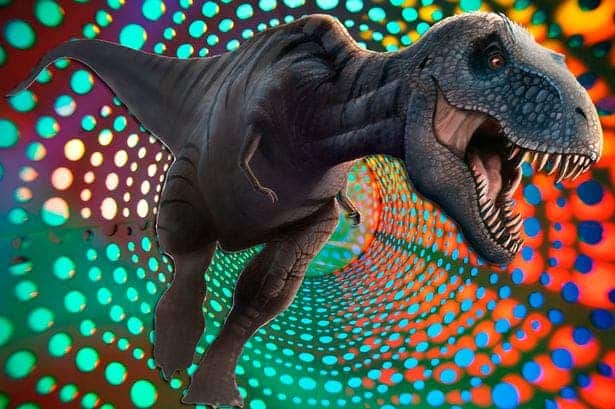Millions of years before rock and roll, LSD and the new age movement, dinosaurs were having a blast in the Cretacious, nibbling on ancient ergot – a parasitic fungus known for its poisonous and potent hallucinogenic effects. The idea is supported by a grass spikelet and ergot sample trapped in a 100-million-year-old piece of amber from Myanmar.
Trippy dinosaurs

Ergot provided the organic basis for the synthesis of LSD (lysergic acid diethylamide) – a potent hallucinogenic often used recreationally, but also proven to be a great catalyst for recovery in psychotherapy. Ergot describes a group of fungi that infect cereal grasses, especially rye, the most notable of which is the ascomycete fungus Claviceps purpurea. When animals or humans eat too much food tainted with ergot, they might overdose and ergotism, a condition sometimes called St. Anthony’s Fire – a horrible burning feeling triggered by constricting blood vessels. During the middle ages countless limbs were amputated due to the ensuing gangrene, but besides the pain, the ergot also attacks the nervous system causing spasms, convulsions, unconsciousness, hallucinations, and psychosis.
History records whole villages poisoned by ergot, most often when the bakeries used ergot-contaminated grain. In fact, some suggest that the famed Salem Witch Trials occurred because of ergot (and overly zealous superstitious people). In the late 1600s in the Puritan settlement of Salem in Massachusetts two young girls, aged nine and eleven, were said to have fallen victim to fits “beyond the power of Epileptic Fits or natural disease,” including screams, strange contortions, and throwing objects. The local doctor, having exhausted all his methods, resorted to explain these strange fits by evoking mysticism. Surely, they must be witches, the good doctor must have thought. Soon enough, others in the village exhibited similar symptoms, further fueling witchcraft suspicions. The deluded bunch was taken prisoner and tried. Nineteen people were hanged. In Salem, as well as during the bizarre “dancing mania” fits which struck Europe from the 14th to the 17th century, a troublesome fungus may have brought mayhem.
But ergot seems have been here on Earth, infecting grasses since the older Jurassic Period, which lasted from about 199.6 million to 145.5 million years ago. This is if we’re to judge this newly-discovered amber fossil dated 100 million years old (middle Cretaceous), when the land was still dominated by dinosaurs and conifers, but the earliest flowering plants, grasses and small mammals were beginning to evolve. The fungus in this specimen was named Palaeoclaviceps parasiticus.
“It seems like ergot has been involved with animals and humans almost forever, and now we know that this fungus literally dates back to the earliest evolution of grasses,” said Dr Poinar, who is the first author of the paper published in the journal Palaeodiversity.
“This is an important discovery that helps us understand the timeline of grass development, which now forms the basis of the human food supply in such crops as corn, rice or wheat.”
“But it also shows that this parasitic fungus may have been around almost as long as the grasses themselves, as both a toxin and natural hallucinogen.”
Considering it’s been so widespread for a long period of time, there’s no doubt in the scientists’ mind that a dinosaur would have eaten ergot-contaminated grasses. What’s debatable is whether the dinosaurs become ill or trippy because of it. They might have just as well felt nothing, rendering the ergot completely harmless. But if ergot didn’t cause dinosaurs to hallucinate, other fungi or toxic plants must have for sure, though it’s very difficult today to identify which of these could do this. It’s interesting nevertheless to think about dinosaurs tripping on LSD. You don’t hear that every day.





